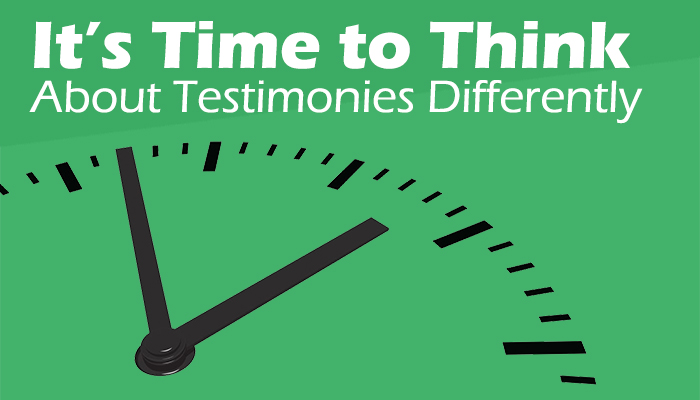
Have you ever heard a story about someone praying for a testimony in the MTC?
The beats of the story are familiar. Someone without a strong testimony decides to serve a mission. They want a testimony badly. They pray about the Book of Mormon or the Church. Then they are given a testimony. Like a little present with a bow on top.
We frame testimonies like this a lot. If we work hard enough, and have enough desire, we will be given a testimony. It’s time to stop.
What is a Testimony?
A testimony is essentially a list of those things we have faith in.
But faith is distinct from belief. Faith is how we live our lives, not how much we believe in things.
Take the story in Mark chapter nine. A father with an ill child comes to Christ. As with many of his miracles, Christ explained that faith was necessary for the miracle to occur. The father said, “Lord, I believe, help thou mine unbelief.” Christ performed the miracle, and the boy was healed.
But if faith was required, how could the unbelieving father produce a miracle? Because his belief or unbelief was entirely irrelevant to his faith. The father behaved as though Christ could perform the miracle, so he had faith.
We demonstrate faith in a principle when we live our life as if it were true, even if intellectually we may have serious reservations. In other words, our testimony is the set of principles upon which we base our decisions. A testimony is not the spiritual experiences or insights that led us to choose those principles.
Take these two examples as proof:
| Laman | Alma The Younger | |
|---|---|---|
| Wicked | ✔ | ✔ |
| Son of the Prophet | ✔ | ✔ |
| Angel Appears to him | ✔ | ✔ |
| Repents | ✘ | ✔ |
or how about Korihor and Zeezrom
| Korihor | Zeezrom | |
|---|---|---|
| Learned Leader | ✔ | ✔ |
| Leading people away from Christ | ✔ | ✔ |
| Hears preaching from Alma the Younger | ✔ | ✔ |
| Repents | ✘ | ✔ |
In each of our examples, both individuals had very similar circumstances, background knowledge, and spiritual experiences. But their testimonies were radically different.
Why Misunderstanding Testimony Matters
This misunderstanding of testimony has crept into our culture. Teenagers look forward to getting their testimony in the same way seven-year-olds look forward to their baptism.
Our testimony meetings are filled with people who emphasize their degree of belief as the most important element of their testimony by pounding the word know when they speak.
On social media, we often see discussions of the gospel where faithfulness is measured in how much we believe, rather than how much we follow.
This culture affects young Latter-day Saints. When we reduce our testimonies to a list of beliefs, we start focusing on our beliefs on a near daily basis, while we should be focusing on our behaviors. No wonder there is a crisis of belief.
And have no doubt, true testimony is a behavior. If it were otherwise, how could it be a prerequisite to enter the temple in line with obeying the law of tithing or chastity?
Rereading Alma 32
Perhaps part of this confusion comes from a misreading of Alma 32. In Alma 32:26-43, Alma presents to the Zoramites a sermon on developing authentic faith.
The most common reading of this section begins with “no more than a desire to believe” in verse 27, and sees a steady progression to the end where “ye shall reap the rewards of your faith.”
But a more careful reading reveals that Alma proposes two alternate paths toward faith building.
The first approach is presented in verses 27-35. This approach is much more academic and focused on acquiring knowledge.
Step 1: Begin an Experiment (27)
Step 2: Plant the seed (28)
Step 3: Do not cast the seed out (28)
Step 4: Watch how the seed grows (29)
Results: You will have knowledge (33) and your faith will be dormant (34)
This academic approach does lead to an increase in belief, but does not lead to an increase in faith.
After saying that the first approach makes your knowledge perfect, Alma begins again in verse 35 and 36 by saying that your knowledge is not perfect. And while the tree had already begun to grow in verse 33. Verse 37 states that the tree “beginneth to grow,” again making it clear that this is a second metaphor. Let’s look at the steps involved in this process.
Step 1: Exercise Faith (36)
Step 2: Plant the Seed (36)
Step 3: Care for the Tree (37)
Step 4: Do not neglect the tree (38)
Results: Everlasting Life
In this second approach, we plant the seed not with experimental skepticism but with faith. We don’t sit back and watch as in the first approach, but we act as though the seed is good (a testimony) by caring for it.
The reward for this faith-based approach is everlasting life, much better than the knowledge gained from the experimental approach.
The Solution
So how can we begin to alter our cultural approach to testimonies?
Let me offer a few ideas:
- Choose your words carefully in testimony meeting — Is there any better place to change how we see testimonies than testimony meeting? Avoid language that focuses on beliefs, and focus instead on behavior. “It has been my experience that . . .” or “When I followed . . .” And when we tell stories, focus on how living the gospel has affected you rather than on your search for belief.
- Focus Sunday School classes on behaviors — The youth “Come Follow Me” curriculum excellently focuses on applying the doctrine to the youth’s day to day lives. Successfully accomplishing this requires strong questions and insistent follow-ups. When we outsource teaching to the youth, they often don’t have the skills necessary to apply the principles to the other students in class. Teachers should always be ready to push the lesson into the application phase, even if they didn’t prepare the lesson themselves. As students, we should also focus on how the presented material can change our behavior, and focus our comments on that.
- Be an Example by choosing a testimony — As always, the most powerful weapon we have is our example. We can be honest about our intellectual doubts, while still choosing to act as though we believe. As we do this, we show ourselves, our children, and others that testimony is something that we choose.





